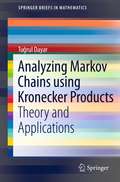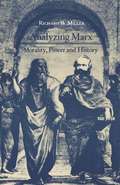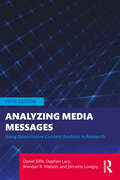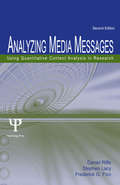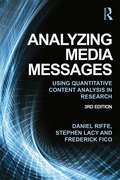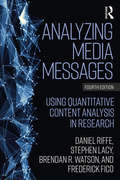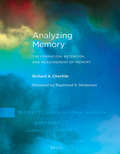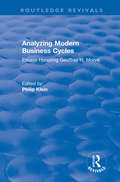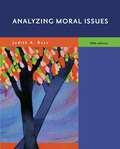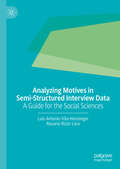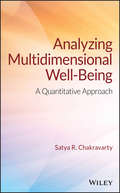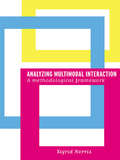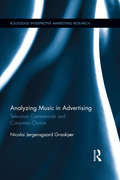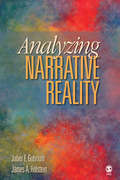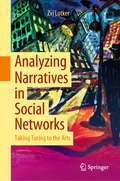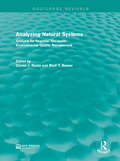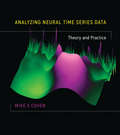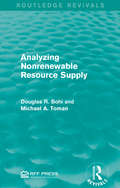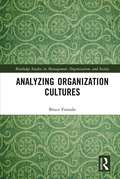- Table View
- List View
Analyzing Markov Chains using Kronecker Products: Theory and Applications (SpringerBriefs in Mathematics)
by Tugrul DayarKronecker products are used to define the underlying Markov chain (MC) in various modeling formalisms, including compositional Markovian models, hierarchical Markovian models, and stochastic process algebras. The motivation behind using a Kronecker structured representation rather than a flat one is to alleviate the storage requirements associated with the MC. With this approach, systems that are an order of magnitude larger can be analyzed on the same platform. The developments in the solution of such MCs are reviewed from an algebraic point of view and possible areas for further research are indicated with an emphasis on preprocessing using reordering, grouping, and lumping and numerical analysis using block iterative, preconditioned projection, multilevel, decompositional, and matrix analytic methods. Case studies from closed queueing networks and stochastic chemical kinetics are provided to motivate decompositional and matrix analytic methods, respectively.
Analyzing Marx: Morality, Power and History
by Richard W. MillerIn this book Marx is revealed as a powerful contributor to the debates that now dominate philosophy and political theory. Using the techniques of analytic philosophy to unite Marx's general statements with his practice as historian and activist, Richard W. Miller derives important arguments about the rational basis of morality, the nature of power, and the logic of testing and explanation. The book also makes Marx's theory of change useful for current social science, by replacing economic determinist readings with a new interpretation in which systems of power relations are the basis of change. Part One discusses Marx's criticisms of the moral point of view as a basis for social choice. The outlook that emerges is humane but antimoral. Part Two argues that Marx's concept of the ruling class is a means, of measuring political power that is ignored yet urgently needed by present-day social science. Part Three bases Marx's theory of history on the dynamics of power, challenging both the standard, economic determinist readings of the theory and standard conceptions of science.
Analyzing Media Messages: Using Quantitative Content Analysis in Research
by Stephen Lacy Daniel Riffe Brendan R. Watson Jennette LovejoyThe fifth edition of this comprehensive and engaging text guides readers through the essential tools and skills necessary to conduct quantitative content analysis research. Readers will find a clear definition of quantitative content analysis and step-by-step instructions on designing a content analysis study, along with examples of content analysis studies and journal articles. This edition has been updated with the latest methods in sampling in the digital age, computerized content analysis, and the uses of social media in content analysis research. It maintains the concise, accessible approach of previous editions while including refreshed examples and discussions throughout. This is an essential text for content analysis courses in communication and media studies programs at all levels, as well as a useful supplementary text in more general research methods courses.
Analyzing Media Messages: Using Quantitative Content Analysis in Research (2nd Edition) (LEA Communication Series)
by Stephen Lacy Daniel Riff Frederick Fico Daniel Riffe<p>Analyzing Media Messages provides a comprehensive and comprehensible guide to conducting content analysis research. It establishes a formal definition of quantitative content analysis; gives step-by-step instruction on designing a content analysis study; and explores in depth research questions that recur in content analysis, in such areas as measurement, sampling, reliability, data analysis, validity, and technology. <p>This Second Edition maintains the concise, accessible approach of the first edition while offering an updated discussion and new examples. The goal of this resource is to make content analysis understandable, and to produce a useful guide for novice and experienced researchers alike. <p>Accompanied by detailed, practical examples of current and classic applications, this volume is appropriate for use as a primary text for content analysis coursework, or as a supplemental text in research methods courses. It is also an indispensable reference for researchers in mass communication fields, political science, and other social and behavioral sciences.</p>
Analyzing Media Messages: Using Quantitative Content Analysis in Research (LEA Communication Series)
by Stephen Lacy Daniel Riff Frederick FicoAnalyzing Media Messages is a primer for learning the technique of systematic, quantitative analysis of communication content. Rich with examples of recent and classic applications, it provides solutions to problems encountered in conducting content analysis, and it is written so that students can readily understand and apply the techniques. This thoroughly revised third edition includes current and engaging examples for today's students, in addition to a number of historically important cases. It emphasizes communication of visual imagery and studies of advertising content. Resources on the book’s companion website provide additional materials for students and instructors, including existing protocols, web links, and a bibliography of content analysis methods articles. This volume is intended for use as a primary text for content analysis coursework, or as a supplemental text in research methods courses. It is also an indispensable reference for researchers in mass media fields, political science, and other social and behavioral sciences.
Analyzing Media Messages: Using Quantitative Content Analysis in Research (Lea's Communication Ser.)
by Stephen Lacy Daniel Riff Frederick Fico Brendan WatsonAnalyzing Media Messages, Fourth Edition provides a comprehensive guide to conducting content analysis research. It establishes a formal definition of quantitative content analysis; gives step-by-step instructions on designing a content analysis study; and explores in depth several recurring questions that arise in such areas as measurement, sampling, reliability, data analysis, and the use of digital technology in the content analysis process. The fourth edition maintains the concise, accessible approach of the first three editions while offering updated discussions and examples. It examines in greater detail the use of computers to analyze content and how that process varies from human coding of content, incorporating more literature about technology and content analysis throughout. Updated topics include sampling in the digital age, computerized content analysis as practiced today, and incorporating social media in content analysis. Each chapter contains useful objectives and chapter summaries to cement core concepts.
Analyzing Memory: The Formation, Retention, and Measurement of Memory (The\mit Press Ser.)
by Richard A. ChechileAn accessible synthesis of memory research that discusses the creation of memory representations, the processes of storage and retrieval, and the effectiveness of encoding information.The field of memory research is subdivided into many separate and non-overlapping topic areas that often employ specialized tools and models. This book offers an accessible synthesis of memory research that explores how memory works, how it is organized, and how it changes dynamically. Written by an expert in the field, it can be used by undergraduate and graduate students of psychology and as a reference by researchers who want to fill in gaps in their knowledge. The book focuses on three general topics that cover a vast amount of research in the field: how a memory representation is created, how the cognitive processes of storage and retrieval can be studied and measured, and the process of encoding information and its varying degrees of effectiveness. Specific subjects addressed include habituation and sensitization, and the neurobiological changes that underlie them; evidence for a cognitive component underlying Pavlovian conditioning; biological constraints on a cognitive model of memory; an information-processing framework for memory; misconceptions about memory, including the static memory myth and the permanent memory myth; model-based measurement of storage and retrieval processes; a critique of the concept of memory strength; the distinction between implicit and explicit memory; and learning and repetition. Although the writing is accessible to the nonspecialist, the density of information is high. The text avoids jargon, and a glossary defines key terms. The notes expand on technical details and point to interesting related ideas.
Analyzing Microbes: Manual of Molecular Biology Techniques (Springer Protocols Handbooks)
by Dilip Kumar Arora Surajit Das Mesapogu SukumarThis Springer Protocols manual is a practical guide to the application of key molecular biology techniques in microbiological research. The focus is on experimental protocols, which are presented in an easy-to-follow way, as step-by-step procedures for direct use in the laboratory. Notes on how to successfully apply the procedures are included, as well as recommendations regarding materials and suppliers. In addition to the practical protocols, important background information and representative results of experiments using the described methods are presented. Researchers in all areas applying microbial systems, such as in molecular biology, genetics, pathology, and agricultural research will find this work of great value.
Analyzing Modern Business Cycles: Essays Honoring
by Philip A KleinThis title was first published in 1990.
Analyzing Moral Issues (5th edition)
by Judith A. BossThis text with readings addresses a variety of timely and interesting moral issues, providing background information and primary source selections for each issue presented. It includes a chapter on ethical theory and covers a broad range of ethical perspectives--among them virtue ethics (Aristotelian and Confucian), Buddhist and feminist care ethics, and the Rawlsian and communitarian approaches. The fifth edition also includes new readings and case studies covering some of the more pressing issues of recent ethical debate, such as genetic enhancement of children, racism and sexism in the 2008 presidential elections, the effect of the U. S. Patriot Act on academic freedom, military conscription, and global warming.
Analyzing Motives in Semi-Structured Interview Data: A Guide for the Social Sciences
by Luis Antonio Vila-Henninger Rosario Rizzo LaraThis book advances the emerging work on using semi-structured interview data to analyze motives by providing the first book-length treatment of this underdeveloped methodological area in sociology and social science more broadly. Exploring key methodological and theoretical debates on this topic in-depth, the authors apply a dual-process model approach to demonstrate how we can analyze motives effectively in semi-structured interview data, and in tandem, understand the sociological reasoning behind society's moral judgments and political decision-making. Additionally, the authors develop the accessible and rigorous 5Rs methodology, which synthesizes insights from an array of literatures into a novel, cohesive analytic tool for analyzing motives in semi-structured interview data. Balancing transparency with theoretical nuance, it enables researchers to revisit and reuse previously collected data that may have been considered unsuitable for motive analysis, either because of prevailing disciplinary assumptions, or because of how data were initially framed and coded. Applicable to various cultural contexts and disciplines, the methodology explored in this book is thus of international interest to researchers and students of qualitative sociology, sociology of culture and cognition, migration studies, cognitive science, and moral psychology, with wider implications for qualitative methodologies in the social sciences.
Analyzing Multidimensional Well-Being: A Quantitative Approach
by Satya R. Chakravarty“An indispensable reference for all researchers interested in the measurement of social welfare. . .” —François Bourguignon, Emeritus Professor at Paris School of Economics, Former Chief Economist of the World Bank. “. . .a detailed, insightful, and pedagogical presentation of the theoretical grounds of multidimensional well-being, inequality, and poverty measurement. Any student, researcher, and practitioner interested in the multidimensional approach should begin their journey into such a fascinating theme with this wonderful book.” —François Maniquet, Professor, Catholic University of Louvain, Belgium. A Review of the Multidimensional Approaches to the Measurement of Welfare, Inequality, and Poverty Analyzing Multidimensional Well-Being: A Quantitative Approach offers a comprehensive approach to the measurement of well-being that includes characteristics such as income, health, literacy, and housing. The author presents a systematic comparison of the alternative approaches to the measurement of multidimensional welfare, inequality, poverty, and vulnerability. The text contains real-life applications of some multidimensional aggregations (most of which have been designed by international organizations such as the United Nations Development Program and the Organization for Economic Co-operation and Development) that help to judge the performance of a country in the various dimensions of well-being. The text offers an evaluation of how well a society is doing with respect to achievements of all the individuals in the dimensions considered and clearly investigates how achievements in the dimensions can be evaluated from different perspectives. The author includes a detailed scrutiny of alternative techniques for setting weights to individual dimensional metrics and offers an extensive analysis into both the descriptive and welfare theoretical approaches to the concerned multi-attribute measurement and related issues. This important resource: • Contains a synthesis of multidimensional welfare, inequality, poverty, and vulnerability analysis • Examines aggregations of achievement levels in the concerned dimensions of well-being from various standpoints • Shows how to measure poverty using panel data instead of restricting attention to a single period and when we have imprecise information on dimensional achievements • Argues that multidimensional analysis is intrinsically different from marginal distributions-based analysis Written for students, teachers, researchers, and scholars, Analyzing Multidimensional Well-Being: A Quantitative Approach puts the focus on various approaches to the measurementof the many aspects of well-being and quality of life. Satya R. Chakravarty is a Professor of Economics at the Indian Statistical Institute, Kolkata, India. He is an Editor of Social Choice and Welfare and a member of the Editorial Board of Journal of Economic Inequality.
Analyzing Multimodal Interaction: A Methodological Framework
by Sigrid NorrisOur perception of our everyday interactions is shaped by more than what is said. From coffee with friends to interviews, meetings with colleagues and conversations with strangers, we draw on both verbal and non-verbal behaviour to judge and consider our experiences.Analyzing Multimodal Interaction is a practical guide to understanding and investigating the multiple modes of communication, and provides an essential guide for those undertaking field work in a range of disciplines, including linguistics, sociology, education, anthropology and psychology. The book offers a clear methodology to help the reader carry out their own integrative analysis, equipping them with the tools they need to analyze a situation from different points of view. Drawing on research into conversational analysis and non-verbal behaviour such as body movement and gaze, it also considers the role of the material world in our interactions, exploring how we use space and objects - such as our furniture and clothes - to express ourselves. Considering a range of real examples, such as traffic police officers at work, doctor-patient meetings, teachers and students, and friends reading magazines together, the book offers lively demonstrations of multimodal discourse at work.Illustrated throughout and featuring a mini-glossary in each chapter, further reading, and advice on practical issues such as making transcriptions and video and audio recordings, this practical guide is an essential resource for anyone interested in the multiple modes of human interaction.
Analyzing Music in Advertising: Television Commercials and Consumer Choice (Routledge Interpretive Marketing Research)
by Nicolai GraakjaerThe study of music in commercials is well-suited for exploring the persuasive impact that music has beyond the ability to entertain, edify, and purify its audience. This book focuses on music in commercials from an interpretive text analytical perspective, answering hitherto neglected questions: What characterizes music in commercials compared to other commercial music and other music on TV? How does music in commercials relate to music ‘outside’ the universe of commercials? How and what can music in commercials signify? Author Nicolai Graakjær sets a new benchmark for the international scholarly study of music on television and its pervading influence on consumer choice.
Analyzing Narrative Reality
by Jaber F. Gubrium Dr James A. HolsteinAnalyzing Narrative Reality offers a comprehensive framework for analyzing the construction and use of stories in society. This centers on the interplay of narrative work and narrative environments, viewed as reflexively related. Topics dealing with narrative work include activation, linkage, composition, performance, collaboration, and control. Those dealing with narrative environments include close relationships, local culture, status, jobs, organizations, and intertextuality. Both the texts and everyday contexts of the storying process are considered, with accompanying guidelines for analysis and illustrations from empirical material. Methodological procedures feature interviewing, ethnographic fieldwork, and conversational and textual analysis. The conclusion raises the issue of narrative adequacy, addressing the questions of what is a good story and who is a good storyteller. Analyzing Narrative Reality is truly multidisciplinary and should appeal to researchers working across the social and behavioral sciences and humanities, as well as to narratively focused researchers in nursing, education, allied and public health, social work, law, counseling, and management/organization studies.
Analyzing Narrative: Discourse and Sociolinguistic Perspectives
by Anna De Fina Alexandra GeorgakopoulouThe socially minded linguistic study of storytelling in everyday life has been rapidly expanding. This book provides a critical engagement with this dynamic field of narrative studies, addressing long-standing questions such as definitions of narrative and views of narrative structure but also more recent preoccupations such as narrative discourse and identities, narrative language, power and ideologies. It also offers an overview of a wide range of methodologies, analytical modes and perspectives on narrative from conversation analysis to critical discourse analysis, to linguistic anthropology and ethnography of communication. The discussion engages with studies of narrative in multiple situational and cultural settings, from informal-intimate to institutional. It also demonstrates how recent trends in narrative analysis, such as small stories research, positioning analysis and sociocultural orientations, have contributed to a new paradigm that approaches narratives not simply as texts, but rather as complex communicative practices intimately linked with the production of social life.
Analyzing Narratives in Social Networks: Taking Turing to the Arts
by Zvi LotkerThis book uses literature as a wrench to pry open social networks and to ask different questions than have been asked about social networks previously. The book emphasizes the story-telling aspect of social networks, as well as the connection between narrative and social networks by incorporating narrative, dynamic networks, and time. Thus, it constructs a bridge between literature, digital humanities, and social networks. This book is a pioneering work that attempts to express social and philosophic constructs in mathematical terms.The material used to test the algorithms is texts intended for performance, such as plays, film scripts, and radio plays; mathematical representations of the texts, or “literature networks”, are then used to analyze the social networks found in the respective texts. By using literature networks and their accompanying narratives, along with their supporting analyses, this book allows for a novel approach to social network analysis.
Analyzing Natural Systems: Analysis for Regional Residuals-Environmental Quality Management (Routledge Revivals)
by Daniel J. Basta Blair T. BowerThis report was undertaken on local, regional, state and federal levels in the United States to analyse the impact residuals have on environmental quality and to emphasise the need for Residuals- Environmental quality management (REQM). Originally published in 1982, this study brings together information on approaches for analysing natural systems and which factors to consider when choosing an approach. This title will be of interest to students of environmental studies as well as professionals and policy makers.
Analyzing Network Data in Biology and Medicine: An Interdisciplinary Textbook for Biological, Medical and Computational Scientists
by Nataša PržuljThe increased and widespread availability of large network data resources in recent years has resulted in a growing need for effective methods for their analysis. The challenge is to detect patterns that provide a better understanding of the data. However, this is not a straightforward task because of the size of the data sets and the computer power required for the analysis. The solution is to devise methods for approximately answering the questions posed, and these methods will vary depending on the data sets under scrutiny. This cutting-edge text introduces biological concepts and biotechnologies producing the data, graph and network theory, cluster analysis and machine learning, before discussing the thought processes and creativity involved in the analysis of large-scale biological and medical data sets, using a wide range of real-life examples. Bringing together leading experts, this text provides an ideal introduction to and insight into the interdisciplinary field of network data analysis in biomedicine.
Analyzing Neural Time Series Data: Theory and Practice (Issues In Clinical And Cognitive Neuropsychology Ser.)
by Mike X CohenA comprehensive guide to the conceptual, mathematical, and implementational aspects of analyzing electrical brain signals, including data from MEG, EEG, and LFP recordings.This book offers a comprehensive guide to the theory and practice of analyzing electrical brain signals. It explains the conceptual, mathematical, and implementational (via Matlab programming) aspects of time-, time-frequency- and synchronization-based analyses of magnetoencephalography (MEG), electroencephalography (EEG), and local field potential (LFP) recordings from humans and nonhuman animals. It is the only book on the topic that covers both the theoretical background and the implementation in language that can be understood by readers without extensive formal training in mathematics, including cognitive scientists, neuroscientists, and psychologists.Readers who go through the book chapter by chapter and implement the examples in Matlab will develop an understanding of why and how analyses are performed, how to interpret results, what the methodological issues are, and how to perform single-subject-level and group-level analyses. Researchers who are familiar with using automated programs to perform advanced analyses will learn what happens when they click the “analyze now” button.The book provides sample data and downloadable Matlab code. Each of the 38 chapters covers one analysis topic, and these topics progress from simple to advanced. Most chapters conclude with exercises that further develop the material covered in the chapter. Many of the methods presented (including convolution, the Fourier transform, and Euler's formula) are fundamental and form the groundwork for other advanced data analysis methods. Readers who master the methods in the book will be well prepared to learn other approaches.
Analyzing New Venture Opportunities
by Michael J. RobertsThe note describes a systematic process for framing and researching the issues that should be analyzed in the course of considering a new venture idea.
Analyzing Non-Textual Content Elements to Detect Academic Plagiarism
by Norman MeuschkeIdentifying plagiarism is a pressing problem for research institutions, publishers, and funding bodies. Current detection methods focus on textual analysis and find copied, moderately reworded, or translated content. However, detecting more subtle forms of plagiarism, including strong paraphrasing, sense-for-sense translations, or the reuse of non-textual content and ideas, remains a challenge. This book presents a novel approach to address this problem—analyzing non-textual elements in academic documents, such as citations, images, and mathematical content. The proposed detection techniques are validated in five evaluations using confirmed plagiarism cases and exploratory searches for new instances. The results show that non-textual elements contain much semantic information, are language-independent, and resilient to typical tactics for concealing plagiarism. Incorporating non-textual content analysis complements text-based detection approaches and increases the detection effectiveness, particularly for disguised forms of plagiarism. The book introduces the first integrated plagiarism detection system that combines citation, image, math, and text similarity analysis. Its user interface features visual aids that significantly reduce the time and effort users must invest in examining content similarity.
Analyzing Nonrenewable Resource Supply (Routledge Revivals)
by Michael A. Toman Douglas R. BohiOriginally published in 1984, Douglas A. Bohi and Michael A. Toman have produced a convenient reference source about disparate elements in the theory of nonrenewable resource supply and about general issues that arise when applying dynamic economic analysis. The authors emphasise the inherently dynamic nature of resource supply decisions, the effects of resource depletion on costs and behaviour, and the influence of uncertainty about costs, prices, and reserves. This title will be useful to students interested in environmental studies and economics, practitioners, and others who need to know more about complex interactions of economic forces and the resource base.
Analyzing Organization Cultures (Routledge Studies in Management, Organizations and Society)
by Bruce FortadoCertain consultants argue leaders can quickly, easily, and considerably alter their organization cultures to improve performance. Conversely, field researchers have described situations where leaders could do little to alter the existing organization culture. Between these extreme positions, a spectrum of varying degrees of leader influence exists, and organizations fall at various places along this spectrum. This book presents five field studies dealing with team, service, and sales cultures where both expected and unexpected outcomes arose. In multiple instances, leaders hoped showing some employee appreciation would compensate for offering below market average wages. Several leadership groups were prospering based on cost cuts or increased sales. Those below often had their work intensified and they were experiencing greater stress. Eight paradoxical situations were uncovered and the interpretations of the participants were based in part on their personal work histories and the history of their current organization. In each case, evidence of employee informal organization and managerial operating cultures were documented. Analyzing Organization Cultures uses detailed case studies of five work organizations to offer a comparative approach to analyzing organizational culture. It shows the latest state of knowledge on the topic and will be of interest to researchers, academics, and students in the fields of organizational studies, management history, human resource management, and organizational theory.
Analyzing Performance Problems: Or You Really Oughta Wanna
by Robert F. Mager Peter PipeAnalyzing Performance Problems gives you a step-by-step process for solving virtually any performance problem you face. Instead of guessing at solutions that won't work, you can save time, money, and frustration by finding the true cause of the problem and identifying the best and most economical way to solve it.
